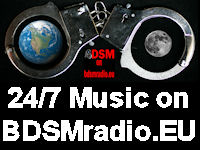BDSM RTV NEWS!!!!
17 september 2008
Self-expression or self-mutilation?
Exploring the evolution of body modifications as an art form
Source: www.excal.on.ca
Many people opt for multiple piercings, such as the second tongue piercing here.
Little beads of sweat had begun condensing on the back of my neck that fateful afternoon in early September. We finally had a lead. There was a guy in Streetsville who said he would probably have an hour or two open after dinner, and we were eager to beat the rush-hour traffic.We had been wandering up and down Queen and Yonge all morning in our quest for an available tattoo artist and failed. I called Kieran, a guy who owns a little parlour called Talisman Studios, only to learn that he was booked solid for the next two or three months. There had to be a place somewhere in this city where I could get ink done.
If your body is a canvas, then body modifiers are on the right track. While tattooing and piercing date as far back as mummification, recent years have seen a resurgence in body alteration in mainstream Western culture. Although once stigmatized and associated with a number of subcultures (such as hippies, punks and the gay BDSM and leather scene), you would be hard pressed to find a 21st-century woman without her earlobes pierced. Sporting a little nostril or eyebrow bling has now become a standard. Many individuals have begun viewing their bodies as artwork, paying attention to elements such as symmetry and overall composition when adorning their skin with jewellery, tattoos, scars or brands. The popularity of body mods is demonstrated, for example, in the success of the Suicide Girls, a soft-core pornographic website that displays erotic photographs of “tattooed goth punk alt” girls and boasts slogans such as “We think the girls in art classes are hotter than the cheerleaders.”
While opponents of body alteration often speak up against the artificial beautification of the body and view body art as disfigurement and mutilation, it was not so long ago that other practices - such as foot binding in Japan or wearing corsets in the Western world - sought to alter women’s bodies in far more long-term and physically harmful ways. It appears that exactly what is deemed an acceptable form of modification depends upon specific societalnorms. And, as evidenced by the television show Miami Ink, there is a living to be made off of subverting some of those norms. In the world of inking, some artists specialize in letters or tribal designs while others are especially adept at life-like realism. Like any large public art show, the Tattoo Expo brings thousands of artists and tattoo enthusiasts under one roof each year and gives them a chance to showcase their artwork.
From its roots somewhere among leather-clad biker gangs and S&M enthusiasts, body modification has gradually evolved into an art medium in its own right. Beyond obvious decorative purposes, body modifications can serve other purposes as well, ranging from spiritual practices to coming-of-age rituals. Among Australian Aboriginals, scarification has traditionally been used as a rite of passage, while the indigenous people of Japan, the Ainu, customarily bore facial tattoos. And who doesn’t have some recollection of movie or television clips containing Burmese Kayan tribe women wearing brass coils around their necks in order to stretch them out to giraffe-like proportions?
A decline in the prevalence of tribal tattooing in Europe is sometimes attributed to the growth of Christianity. After several decades of lurking in the sidelines, however, many forms of body modification are once again turning into commonplace forms of personal expression. While some of us may have parents who still believe that tattoos are reserved solely for sailors, many people today perform piercing, tattooing, branding or scarification in order to commemorate something, publicly communicate an idea or to denote a period of suffering and sadness in the wearer’s life. The endorphins released by the body to combat the pain inherent in the procedure are said to bond the wearer more strongly with his or her body mods.
“You suffer for your piercing or your tattoo, and that makes you appreciate it more. It’s like during childbirth [ . . . ] pain fosters attachment,” says Brampton piercer Jordan Ross, who proudly sports six tattoos, including a half sleeve, as well as 18 piercings. While most readers are certainly familiar with procedures such as eyebrow or nostril piercing, there is more to the world of body modification than that. Surface piercing refers to jewellery that sit just below a thin layer of skin, such as on the sides of the nape, beside the hip bones or going all the way down both sides of the back to mimic old-fashioned corsets. Stretching refers to the gradual increasing of gauge size in any piercing, a process designed to make the piercing hole become increasingly bigger.
Scarification is the process used to intentionally create a scar on the skin, typically of a certain image or design, either with a sharp object like a knife or a hot metal brand. Much less widespread, the practice of tongue splitting (or tongue bifurcation) involves cutting the tongue from the tip to the center into two forks, creating a snake-like appearance. A similar procedure is sometimes done to the male genitalia. Is it art or is it deviancy? Even in the helter-skelter world of body alterations, is there a line to be drawn? It seems contradictory to condone one form of body art (like tattoos), while classifying facial or genital piercings as taboo. How can one differentiate between the wrist-slitting of a depressed teenager and the personal meaningfulness of a name cut into someone’s forearm following a harrowing break up?
The answer is that you can’t - ultimately, beauty (and art) are in the eye of the beholder.

